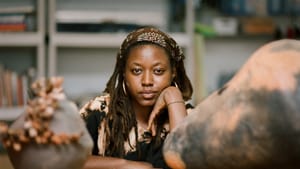Remembering from the root
Ancestral memory in materials and art with Adebunmi Gbadebo

It is a communal and generational work, which means too it is a family work, of memory and preservation. For decades now––through family reunions, storytelling, cemetery caretaking, historical research, and oral history—contemporary family descendants of enslaved African people who lived and died on the Lang Syne Plantation and True Blue Indigo Plantation in South Carolina have preserved and transmitted the heritage from their forbearers, as well as defended it from effacement or erasure. The new exhibit Songs for Ritual and Remembrance, now open through Sunday, September 17, 2023, at the University of Pennsylvania Arthur Ross Gallery, looks to explore this work.
The art of remembering
Multimedia artist, potter, sculptor, papermaker, and collagist Adebunmi Gbadebo is a daughter and granddaughter in one of these families. From her early childhood attending her family’s reunions, she was exposed to the example of and immersed in the environment of this work of memory and preservation. But, as she told me when I spoke with her about her work, “it wouldn’t be until years later that [she] made the connections” with her art. While an art school student, she realized that her ancestral family memories and the materials of her art are inseparable.
For Gbadebo, there is ancestral memory in the material substance with which she makes her art, such as African American hair, clay from the land on which her ancestors lived and died as enslaved people, and indigo like that which her ancestors produced while enslaved. As a young artist, while experimenting in different mediums, she developed her understanding not only of how to wield various materials, but of the meaning of an artist’s material in itself. What material(s) should she choose to work with and why? In other words, what heritage and what history did she want to experience as living and present in the materials with which she made her art?
Black material
Gbadebo tells what she calls her "origin story" about how she realized that she needed to work with, call it, the materiality of memory in her family heritage and inheritance. It happened during an art history course she attended while in art school in New York City. "Art history is told primarily through the material, paint,” Gbadebo explained. “As much as it is talking about the evolution of artists and styles and movements, it also is a history of this material." In one class, the professor presented a painting of a nude Black woman, the first of its kind, but talked about everything except the Black woman herself. In effect, before Gbadebo's very eyes, the professor had effaced the central subject of the painting––the Black woman––and thus made her too feel “invisible” and “erased.” It was then, too, that she made the connection between this personal feeling of de facto erasure and a similar effacement or erasure of her family’s slave history and what materially remains of it today.
“In that moment,” she recounts, “I decided: I am done with the material, [with] paint. And I thought: what material is a Black material? What material describes Black politics and culture and spirituality, and all these things? And for me, it was here.” “Here,” that is, where she’d been since her early childhood, among the materials which directly connect her to her enslaved ancestors. Exactly like Proust’s narrator in In Search of Lost Time, Gbadebo discovered: “The past is hidden somewhere outside the realm, beyond the reach of intellect, in some material object (in the sensation which that material object will give us).” When we chance to come upon this object, the past within it returns “to share our life.” For Gbadebo, the works which result from this, as she says, “carry the stories of ancestors, families, and individuals either long overlooked or too closely surveilled."
What, When, Where
Songs for Ritual and Remembrance. Through September 17, 2023, at the University of Pennsylvania Arthur Ross Gallery, 220 South 34th Street, Philadelphia. Free. (215) 898-2083 or arthurrossgallery.org
Accessibility
The accessible entrance is through the Duhring Wing on the south side of the building across from Irvine Auditorium. This entrance is accessible from the path off of 34th Street, the path from College Hall, and can be reached from the parking lot, as well. The entrance is level with the walkway and has an automatic-operated door. This entrance serves as the accessible entrance to the Arthur Ross Gallery, as well as to the Fisher Fine Arts Library and the elevator.
Sign up for our newsletter
All of the week's new articles, all in one place. Sign up for the free weekly BSR newsletters, and don't miss a conversation.
